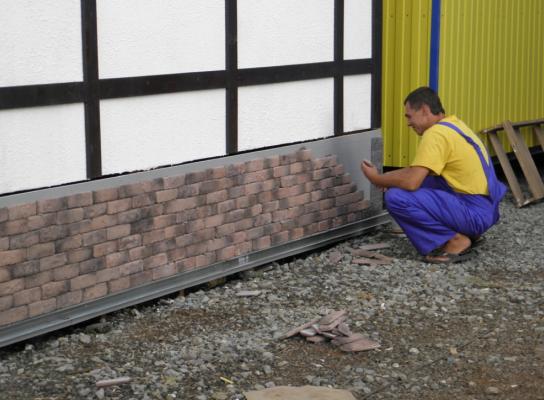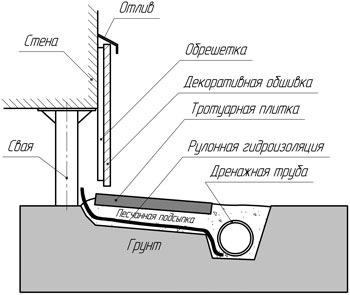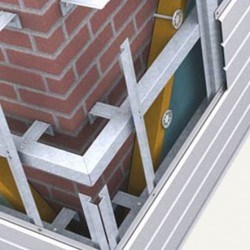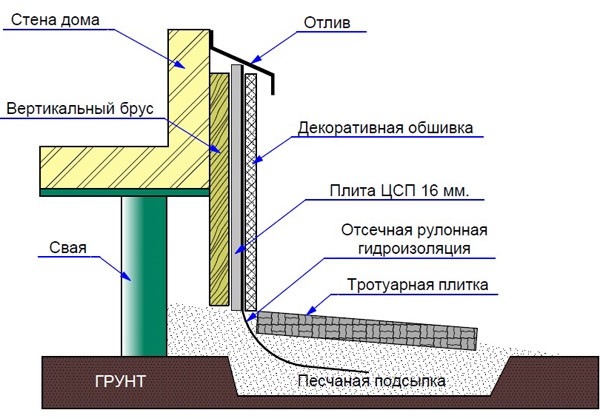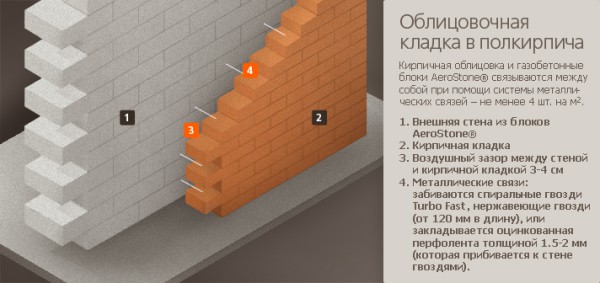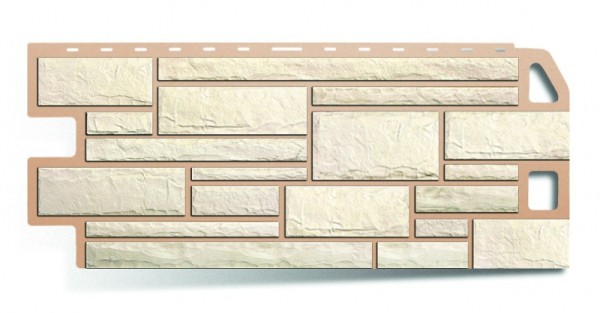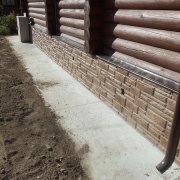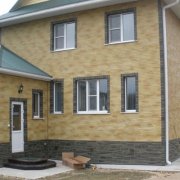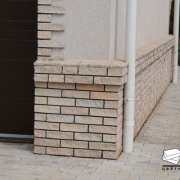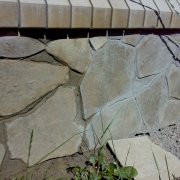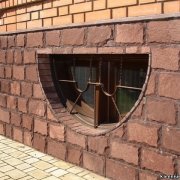Facing the foundation with siding and other materials
Design and decoration of the facade of the house plays a big role for the entire structure as a whole. To do this, there should be a wall cladding and foundation not only attractive in appearance, but also high-quality.
What material to choose for facing the foundations, we will understand in more detail.
The content of the article
What materials are used to finish the base
Foundation cladding do-it-yourself involves the use of various artificial and natural materials.
These include:
- Brick finish, which requires a series of expensive work.
- Facing stone for foundations (artificial and natural). It will also require a number of preparatory work.
- Cladding with plaster is the simplest and most common option.
- Porcelain stoneware for facing the foundation is also often used.
- Decorating with plastic decorative panels, easy installation and attractive pricing.
- Facing the foundations with siding. This option provides a number of positive characteristics in front of other finishing materials, which we will consider below.
Before you make the facing of the foundation siding, consider its technical characteristics:
- Basement siding panels are very similar in appearance to vinyl structures, but much stronger and more reliable.
- Basement siding is reminiscent of the external parameters of sandstone for facing the foundation, but it is easier to install, and the price is lower.
Note. The operational period is more than 50 years and the installation is done with your own hands, without involving specialized assistance. A long service life indicates the strength and reliability of the material.
- Siding resistant to external mechanical damage and adverse weather effects.
- Thanks to the finish, it is possible to ensure the proper ventilation of the foundation and base.
- Due to the low thermal conductivity, heat is guaranteed in the building all year round.
- Siding does not fade in the sun and is resistant to temperature extremes.
Before making the installation, it is recommended to get acquainted with the features of the installation, there is a certain instruction for this.
Foundation for siding, installation features
If the insulation and facing of the foundation are done correctly, then the material will retain its operational positive properties for a long period. Let's consider in stages how the finishing work is carried out.
We prepare the walls for installing the lathing:
- Before installation work is carried out, it is necessary to check that the structure gives maximum shrinkage.
Note. For a lightweight foundation, it will take about 6 months.
- Further, it is necessary to provide that the basement and structure walls are dry. The maximum humidity is 4.5% at a depth of 3 cm.
Attention! If the material is installed on a damp base, then the frame will deform over time, and the siding finish will become unusable.
- Therefore, before being produced facade cladding foundation, it is necessary to thoroughly clean the surface and dry it.
- For this, the base is treated with a special soil mixture of deep penetration, which will become an obstacle to mold and its penetration.
- If a close occurrence of groundwater is detected, then additional waterproofing is recommended.
It is also necessary to provide for the presence of a flat wall surface, the maximum difference of no more than 2 centimeters.
Installation of the lathing
Siding for the foundation is recommended to be installed only on a metal frame, since the finish is external. For this, special galvanized profiles are used.
Attention! Exterior siding can not be mounted on a wooden crate, since the base and foundation are most exposed to moisture, and the tree absorbs it perfectly.
Work:
- The metal crate is mounted strictly according to the level, the work starts from the lower J-profile.
- Then, along the plumb line, door and window openings and corner profiles are installed.
Siding Installation
Thanks to the latest technologies in the construction industry, several options for installing material that can be produced independently are offered.
Namely:
- Material with lock fasteners, installation method, like vinyl siding (bottom to top).
- Siding with fasteners as sockets and pins and are installed from top to bottom.
Note. Given that the installation of the material is carried out under certain weather conditions and temperature conditions, manufacturers have taken care of the maximum ease of installation.
For example, the basement siding "dragon" is equipped with a built-in thermostat, which shows the temperature of the material, which extends the operating period.
Decorative texture of siding
Due to the variety of colors and textures, it is possible to create the most unique design solutions.
You can use the material:
- Under a stone for facing the foundation.
- Brick.
- Torn artificial stone.
- Sandstone.
This material, this is one of the best options, which provides for facing the cottage foundation.
Do it yourself foundation stone foundation
To group natural stone includes the most expensive types of finishing materials. This group is distinguished by reliability and durability.
If the outer cladding is done correctly, then the material will not cause trouble for a long operational period.
Note. In order to reliably protect the structure, both heavy and light materials are used, but reliable, such as flagstone for facing the foundation, granite, marble.
Installation Technology:
- Stone slabs can be installed on the surface with a special adhesive composition.
- For heavier material, you can use special fasteners, which includes: reinforced mesh, hooks and pegs.
Note. If a special mounting frame is not used for heavy material, the material may fall off in the near future.
For light rock, a hydrophobic composition is used as a protective agent.
Artificial foundation lining: installation technology
All materials that imitate the drawing of natural stone have long gained popularity among users. Moreover, the artificial facing of the foundation, in its external parameters, is no different from the natural finish.
Also, blocks for facing the foundation have often been used recently.
Characteristics of artificial material:
- As you know, artificial material is made on the basis of concrete mixture, and ceramic aggregate, expanded clay, pumice and pearlite are used as filler.
- The color scheme and texture is determined by the manufacturing technology and the use of dyes, which support the imitation of natural material.
- Ease of installation consists in leveling the surface where the installation will be carried out.
- Artificial material is installed using a special composition on the basement surface.
To simplify the installation of the material, it is recommended to watch the training video.
Foundation brick finish
Choosing brick as the finishing material for the foundation will make it possible to complete the design. Often, instead of brick, a tile imitating masonry is used as a finishing material, since brick itself is a heavy material
Most often used for decoration clinker tiles:
- It is a thin plate, which is very similar to brickwork, with special corner elements that allow you to make beautiful corners without seams.
- Installation is carried out using cement mortar.
Note. Also, as a substitute for brick, polymer sand tile is used, which is fastened with screws.
To date, the popular finishing materials can also include finishing with flagstone and porcelain.
Plastic facing of the foundation and its features
Before that, we examined the types of materials that are more suitable for finishing monolithic foundations. It is more rational to use PVC panels of different sizes for pile and columnar foundations.
Note. For this type of bearing base, stone decoration is also suitable, but in this case, you will need to create a supporting wall that can support the weight of the material, and then decorate the structure. Then much more time and financial costs will be required.
Features of installing plastic panels:
- The foundation columns themselves create the skin. In this case, it remains to perform the crate under the frame.
- The duration of the operational period depends on the manufacturing technology of the material.
- Most often, the material is used when the facade of the house is finished with the same material.
Finishing starts from the corner of the house, and all work is carried out from right to left. Before finishing work, in addition, the foundation is fixed in the masonry between the joints of the reinforcement.
It is also recommended that ventilation be provided in advance to extend the life of the foundation.
